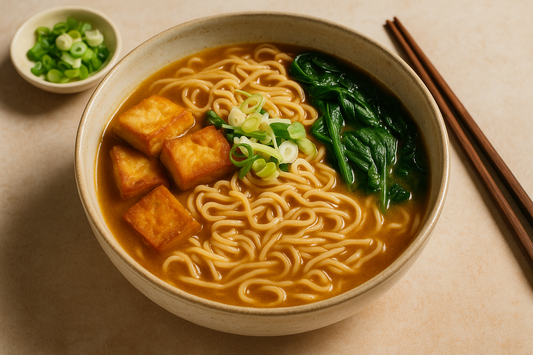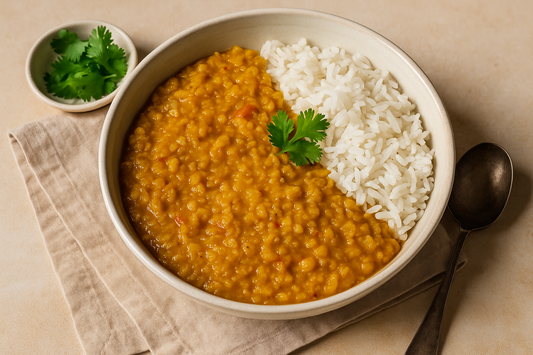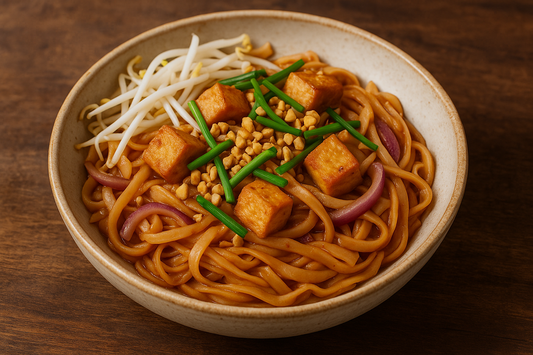If you're a ramen lover, chances are you've come across the two most iconic types: tonkotsu and miso. One is rich and creamy, the other is hearty and deeply savoury. But when it comes to balancing flavour, nutrition, and plant-based eating — which one comes out on top?
In this article, we’ll compare tonkotsu vs miso ramen, explore how these two styles differ in origins, flavour, ingredients, and health impact — and explain why plant-based miso ramen is becoming the go-to choice for more Australians.
We’ll also show you how we’ve reimagined miso ramen in a vegan-friendly format that’s rich, nourishing, and ready to heat and eat.
What Is Tonkotsu Ramen?
Tonkotsu (豚骨) ramen hails from Fukuoka, Japan, and is made by boiling pork bones for hours until the broth turns creamy and opaque. It's known for its deep, rich umami flavour, often paired with thin noodles and topped with slices of pork belly (chashu), green onion, garlic oil, and a soft-boiled egg.
Key Characteristics:
-
Creamy, fatty broth
-
Animal-based, typically high in saturated fat
-
Strong, meaty flavour
-
Slow-cooked preparation
While it's a staple in traditional ramen houses, tonkotsu ramen doesn’t lend itself easily to plant-based adaptations — and for many health-conscious eaters, its richness can feel too heavy.
What Is Miso Ramen?
Miso ramen originated in Hokkaido and is built on a broth infused with fermented soybean paste (miso). This gives it a savory, slightly sweet, and nutty profile — all without relying on meat.
Key Characteristics:
-
Broth made with miso paste (fermented soybeans)
-
Balanced umami with natural sweetness
-
Pairs beautifully with vegetables and plant proteins
-
Ideal for vegan and vegetarian adaptations
Miso ramen is not only easier to veganise — it also offers gut-friendly benefits due to the fermented miso paste, which contains natural probiotics.
Comparing Tonkotsu vs Miso: Nutrition, Taste & Sustainability
1. Flavour Depth
-
Tonkotsu: Strong, fatty, meat-based umami. Rich and creamy.
-
Miso: Umami-forward with added complexity from fermentation. Pairs well with a wide range of plant-based toppings like mushrooms, tofu, and greens.
Winner: Tie — depends on your taste preference. Miso wins in versatility.
2. Nutritional Value
-
Tonkotsu is high in saturated fat and cholesterol, and typically heavy on the stomach.
-
Miso ramen can be made with lighter broths, fresh vegetables, and whole grains — especially when plant-based.
Winner: Miso ramen, especially in a vegan format.
3. Gut Health
-
Tonkotsu contains gelatin and collagen, but lacks plant fibre and probiotics.
-
Miso, as a fermented food, can support gut microbiome balance and digestion when minimally processed.
Winner: Miso ramen
4. Environmental Impact
Tonkotsu’s pork-based preparation results in a higher carbon footprint, while miso ramen — particularly with plant-based toppings — is significantly more sustainable.
Learn more in our related blog:
➡️ Plant-Based Meal Delivery and Gut Health: What the Science Says
How We Reimagined Miso Ramen at Pam Pam
At Pam Pam, we’ve created a plant-based version of miso ramen that brings the same comforting depth — minus the meat.
🍜 Miso Ramen Noodle
Our miso ramen is:
-
Packed with veggies like shiitake mushrooms
-
Topped with plant-based pork
-
Made with gut-friendly miso broth
-
High in plant-based protein
-
Free from preservatives or additives
It's ready to heat and eat — perfect for a quick, healthy lunch or dinner.
Explore how we build flavour without compromise in our blog:
➡️ Miso Ramen vs Tonkotsu: How We Make Our Plant-Based Miso Ramen Rich and Flavourful
FAQ: Tonkotsu vs Miso Ramen
Is miso ramen healthier than tonkotsu?
Yes — miso ramen can be lower in fat and calories, especially when made without animal products. It also offers probiotic benefits due to miso fermentation.
Can vegans eat miso ramen?
Absolutely. Miso ramen can be made entirely plant-based, using miso paste, mushrooms, tofu, and vegetable broth. Check out our vegan Miso Ramen Noodle.
Why is tonkotsu so rich?
Tonkotsu uses pork bones simmered for hours to release fat and collagen, creating a creamy broth. While delicious, it’s heavy and difficult to adapt for vegan diets.
Final Thoughts: Which One Should You Choose?
If you’re looking for a hearty, nourishing ramen that’s lighter on the body, miso ramen — especially in its plant-based form — is the clear winner. It offers a great balance of flavour, health benefits, and sustainability.
And with Pam Pam’s ready-made Miso Ramen Noodle, you can enjoy a comforting bowl that fits your lifestyle — no prep required.









